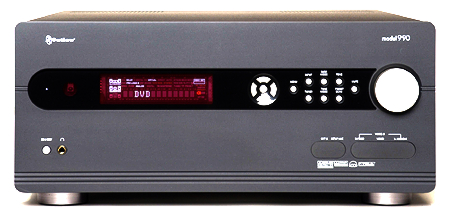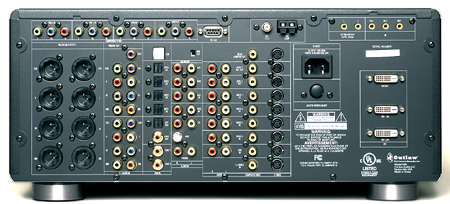Outlaw Model 990 Preamp/Processor

For that amount, by all rights you should not expect much. But in fact you get balanced audio outputs, DVI switching, and automatic speaker calibration using a microphone, three high-end features among many others. It's even upgradeable, through built-in RS-232 and USB ports. The USB port can also be used to connect a computer, turning your audio system into a magnificent set of computer speakers.
The 990 is the successor to the popular Model 950 that came out three years ago. I did not review that product, but judging from the online chatter, it had quite a following, which led to some anticipation and advance orders for this updated version.
Pre-pros are the heirs to more than 40 years of evolution of complex, multi-function audio electronics, beginning with the first stereo receivers that came out in the early 1960s. My father was an audiophile, and I remember admiring his gold-front Fisher stereo receiver in the mid-1960s. It seemed the pinnacle of audio achievement. In fact, I still have it, a cherished antique.
The Outlaw 990, of course, lacks something that receivers have: power amps. But unlike most pre-pros, it includes an AM/FM tuner and a moving magnet phono input as well. Along with these retro features, the 990 also offers most features that consumers have come to expect in modern processors, including a full panoply of inputs and outputs, setup options, and digital audio formats, including DTS-ES Matrix and Discrete, DTS Neo:6, Dolby Digital EX, and Dolby Pro Logic II/IIx.
First Glance
It's a big unit, as any processor that provides every possible input/output you might want must be these days. Generally, the size of a processor is determined by the back panel, not the front. But, at 28 pounds, it is surprisingly light for its size. My Lexicon MC-12B, the reference product to which I compare other processors, weighs 36 pounds. The heft of the power supply is one determinant of weight, but so is the case. All in all, a heavy unit does not necessarily sound any better than a lighter one.
The front panel is relatively Spartan, as one expects from an Outlaw product. On the bottom left sits the power switch and the headphone jack. A small but more-than-adequate display sits in the middle. Older Outlaw processors allowed you to run the setup routine using only this onboard display, but this one does not. It requires that the unit be connected to a video display, which is fine by me.

On the bottom right are two small wells for audio and video inputs. Initially, I found them distressingly unattractive and cheap-looking. But then I found two plates among the accessories that cover the holes and sit flush with the front panel. With that, I decided this was actually a nice benefit allowing easy access to the jacks without the unappealing look of them.
Among these front-panel inputs is one for the setup microphone (included). You can set up the processor yourself, or let the processor do it automatically using the microphone. But be aware: you will probably need a small mic stand. The microphone offers a screw-attachment for one.
On the rear is an impressive array of inputs—almost every possible option. One controversial choice, however, was the decision to include DVI switching instead of HDMI. Of course, DVI is the modern connection for digital video signals. But HDMI combines both video and audio information in one cable and seems to be the connection of choice on most current-generation displays. (Its connector is also smaller than DVI.) The 990 includes two DVI inputs and one output, allowing the receiver to switch between two DVI-equipped sources.
Recognizing the debatable nature of this choice, Outlaw includes a discussion of it in an online Q&A for the 990 (www.outlawaudio.com). Outlaw says it chose DVI over HDMI because the specifications for HDMI are "still a moving target, with the 1.2 specifications still awaiting final release." That may be so, but some high-end displays now come with HDMI as the only digital input. At one point in the instructions, Outlaw advises using a DVI-to-HDMI adaptor (not provided). In theory, that should not affect the signal in any negative way, as all the adaptor does is remove the discrete audio information. But I have no experience with these adaptors.
(I have used both separate DVI to HDMI adapters and adapter cables with DVI connectors on one end and HDMI on the other. I have found no performance downside to either so far. But DVI to HDMI adapters—with an HDMI plug that fits into an HDMI jack on one side and a DVI jack on the other side, are cumbersome. They pull out too easily on the HDMI side from the combined weight of the adapter itself and the DVI connector that plugs into it. The opposite type of adapter, HDMI to DVI—the sort you might use on the 990—work fine because the DVI end has locking screws for a firm connection and the HDMI plug on the backside is much lighter than a DVI connector.—TJN)
For many people, the choice of DVI over HDMI will actually make little difference. For example, I do not use the video switching on my Lexicon, which is too old to provide digital video switching. My Faroudja VP-5000 video processor, like most TVs, provides more than enough inputs to accept my principal video sources—DVD, HD receiver, cable, and satellite. Why add another layer of video signal manipulation if you don't have to? I'm sure many people have made the same choice. Of course, the audio signals from these and other devices do run through the Lexicon. So that is how I set up the Outlaw, by moving the audio cables, input for input, from the Lexicon to the Outlaw. (I did have a look at the Outlaw's component video switching; more on that later.)
The online Q&A also asked and answered the question of whether this unit's switching will be fully compatible with the new high-definition DVD players that are due to come out late this year or early next. Outlaw offered reassurance that it would, but said no more because it has signed confidentially agreements in order to be included in the relevant meetings and discussions. It's a small gamble, whatever you might buy now. But it is a potential concern only for those people intent on using their processor as a video switcher. (Unless, of course, the decision is made to deliver the audio for these HD formats only on an HDMI link and not on a standard SPDIF (coaxial) or optical digital audio connection. This would be an absurd arrangement (locking out most current potential customers for the format), but we don't rule out anything when Hollywood and copy protection are mentioned in the same breath.—TJN)
The unit also offers three wideband component inputs (suitable for any sort of signal) as well as seven S-video and 10 composite inputs. It can also transcode among all of them (except DVI), allowing the unit to move signal streams back and forth between inputs without conflict.
The remote is, well, familiar. It is a nicely backlit unit that offers access to everything you might want to do. And, not incidentally, it is the same third-party remote that Lexicon provides with the MC-12, labeled differently, of course.
I have used the Lexicon remote for several years and have come to like it quite a lot. Not only is it backlit, the labels for each button are on the button so users can read them in the dark. The only two exceptions are the volume up/down and signal-format scroll up/down buttons; to this day, I continue to get them confused in the dark. The Outlaw version has the same flaw but also one improvement: It doesn't buzz when you turn on the backlight. Granted, the Lexicon's buzz isn't very loud (you'd have to be in a totally quiet room to hear it), but the Outlaw version is perfectly quiet.













































